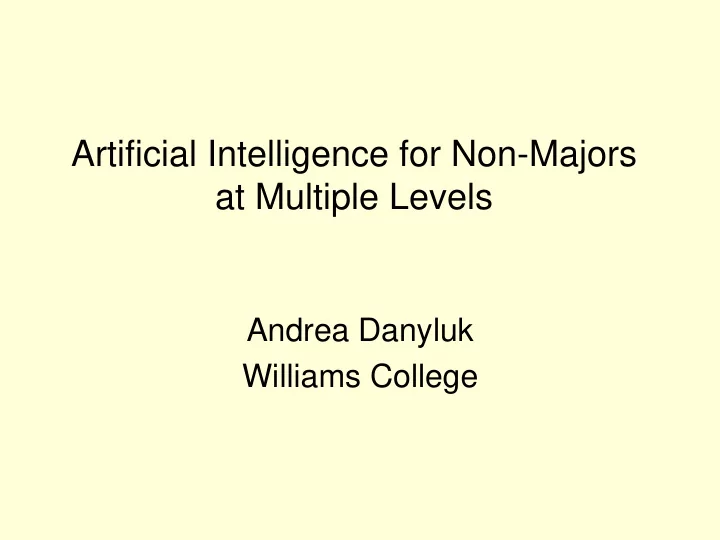

Artificial Intelligence for Non-Majors at Multiple Levels Andrea Danyluk Williams College
Outline • Will claim that we can draw students to CS through two kinds of courses – Introductory courses – Accessible electives of relevance to other fields Think “French Drain” • Two courses (syllabi and materials) – Intro for non-majors – Elective on machine learning • Will argue that this isn’t just about AI
AI: Image and Reality • One of several theme-based intros – For non-majors: AI, Graphics, Game Design, BioInformatics – For majors: Networks • Offered every 2-3 years since S95 • S99 version introduced robotics emphasis (Meeden)
Goals • Introduce students to fundamental questions of computer science • Programming and problem solving (for those who might want to go on) Give an accurate picture of CS • Safe environment for all students • Motivate students to continue with CS
Course Format • 3 50-min lectures/discussions per week • 1.5-hour (or 3-hour) lab per week • 12 week semester
Student Work • Reading – Textbook – Position papers on AI, Philosophy, Psychology – Fiction • Reading response on discussion topics • Four problem sets • Lab (group) work - construction and programming of simple robots
Lecture Syllabus • First 6 weeks: Robotics – Applications and challenges – Robot parts: sensors and effectors – Classical planning vs behavorial approach – Interactive C programming • Last 6 weeks: General AI topics – Knowledge representation and reasoning – Search; games – Learning; NLP; Vision
Other Topics • Robot ethics • Creativity • The nature of intelligence
Lab Syllabus • Soldering and wiring • Testing • Building robot chassis • Touch sensing • Sonar vs touch navigation • Line following • Trashbot (multiweek) [Hank / Elevator] Link to all course materials in paper
Enrollment Outcomes Enrolled Majors Other Courses CS F06 4 1 of 18 2 3 F04 10 0 8 9+4 F00 15 2 of 14 6 12 S99 14 0 5 10
Why call it a success? • Small liberal arts college • Low enrollments but high satisfaction • Fall 2006: 4 students, but – 3 women (1 now a CS major) – 2 African American
Machine Learning: not just for the CS major … employed a new, high -powered type of statistical analysis called “machine learning”
Electives as a hook into CS • Relevance to other disciplines • Advocates in other departments • Relatively small number of hurdles – CS1 – CS2 (Data Structures) – Discrete Math
Tutorial Course Format • Modeled roughly on tutorial style of teaching at Oxford • Students meet once per week with instructor in pairs • Instructor assigns reading and paper topic of the week • One student presents paper; other presents critique Students take more responsibility for learning
Machine Learning Tutorial • Like AI, requires only CS1, CS, Discrete Math • Primary focus on classification (Naïve Bayes, ANNs/Backprop, Support Vector Machines, Decision Trees, kNN, ensembles) and regression • Evaluation methodology • Computational learning theory
Weekly Work • Textbook readings on the topic of the week • Problem set • Implementation and critique • Research paper, critique, and critique of critique See link in paper for sample assignments
Tutorial Sessions • Presentation of problems at the board • Weeks with research articles – One student presents research paper and offers initial critique – Other student presents evaluation of first critique + evaluation of research article • Weeks with implementation – General discussion of algorithm, problems, issues – Student code review
Some Tutorial Stats • College-wide – 50 offered 2007-08; >60 in 2006-07 – Most Physics electives are tutorials • In Computer Science – Offer two each year – Class of 06: 2 of 9 majors took none – Class of 07: 3 of 16 took none (some took 3, 4, or even 5 in CS) – Class of 08: 3 of 13 will have taken none
Appeal of Tutorials • Both strong and weak students • Combination of independence and one- on-one attention • Natural format for teaching a diverse group of students – Last week’s Decision Tree discussion: one group didn’t get beyond problem set
Adapting for Other Settings • Alternative to seminar • Guided independent study – More classroom contact hours than standard lecture – More directed than independent study in general • Lecture + conference – Level- or interest-based conference sections – “Interest” can be “disciplinary” or “skill”
Summary • Syllabi and materials for two very different courses • Can draw students to CS through AI at all levels
More General Conclusions • This isn’t just about AI – Computational Thinking (Wing) – Other disciplines becoming more computational • Need to forge relationships with other departments and programs
What we can do • Advertise CS in other departments – CS1 counts as half elective in Chem – Any CS above intro level is half elective in Phys – 109 advertised by Studio Art Chair • Cross-list courses – Game design course is also Art – Theory of Computation is also Math – Bioinformatics is also Bio, Chem, Phys… Need to be open to such requests from others
Thank you
Recommend
More recommend